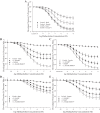Protective effect of sex on chronic stress- and depressive behavior-induced vascular dysfunction in BALB/cJ mice
- PMID: 25123201
- PMCID: PMC4217050
- DOI: 10.1152/japplphysiol.00537.2014
Protective effect of sex on chronic stress- and depressive behavior-induced vascular dysfunction in BALB/cJ mice
Abstract
The presence of chronic, unresolvable stresses leads to negative health outcomes, including development of clinical depression/depressive disorders, with outcome severity being correlated with depressive symptom severity. One of the major outcomes associated with chronic stress and depression is the development of cardiovascular disease (CVD) and an elevated CVD risk profile. However, in epidemiological research, sex disparities are evident, with premenopausal women suffering from depressive symptoms more acutely than men, but also demonstrating a relative protection from the onset of CVD. Given this, we investigated the differential effect of sex on conduit artery and resistance arteriolar function in male and female mice following 8 wk of an unpredictable chronic mild stress (UCMS) protocol. In males, plasma cortisol and depressive symptom severity (e.g., coat status, anhedonia, delayed grooming) were elevated by UCMS. Endothelium-dependent dilation to methacholine/acetylcholine was impaired in conduit arteries and skeletal muscle arterioles, suggesting a severe loss of nitric oxide bioavailability and increased production of thromboxane A2 vs. prostaglandin I2 associated with elevated reactive oxygen species (ROS) and an increased level of systemic inflammation. Endothelium-independent dilation was intact. In females, depressive symptoms and plasma cortisol increases were more severe than in males, although alterations to vascular reactivity were blunted, including the effects of elevated ROS and inflammation on dilator responses. These results suggest that compared with males, female rats are more susceptible to chronic stress in terms of the severity of depressive behaviors, but that the subsequent development of vasculopathy is blunted owing to an improved ability to tolerate elevated ROS and systemic inflammatory stress.
Keywords: clinical depression; endothelium-derived factors; models of chronic stress; nitric oxide; peripheral vascular disease; vasodilation.
Copyright © 2014 the American Physiological Society.
Figures










Comment in
-
Connecting the dots--establishing causality between chronic stress, depression, and cardiovascular disease.J Appl Physiol (1985). 2014 Nov 1;117(9):957-8. doi: 10.1152/japplphysiol.00856.2014. Epub 2014 Sep 25. J Appl Physiol (1985). 2014. PMID: 25257872 No abstract available.
References
-
- Antonijevic IA. Depressive disorders – is it time to endorse different pathophysiologies? Psychoneuroendocrinology 31: 1–15, 2006 - PubMed
-
- Bayramgurler D, Karson A, Yazir Y, Celikyurt IK, Kurnaz S, Utkan T. The effect of etanercept on aortic nitric oxide-dependent vasorelaxation in an unpredictable chronic, mild stress model of depression in rats. Eur J Pharmacol 710: 67–72, 2013 - PubMed
-
- Beck KD, Luine VN. Sex differences in behavioral and neurochemical profiles after chronic stress: role of housing conditions. Physiol Behav 75: 661–673, 2002 - PubMed
-
- Bilici M, Efe H, Koroglu MA, Uydu HA, Bekaroglu M, Deger O. Antioxidative enzyme activities and lipid peroxidation in major depression: alterations by antidepressant treatments. J Affect Disord 64: 43–51, 2001 - PubMed
MeSH terms
LinkOut - more resources
Full Text Sources
Other Literature Sources
Medical

